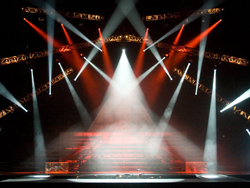
Look For Opportunities
Instead of waiting for the next gig to hone your skills, you need to find other avenues. The first place to look is your local lighting shop. Many companies will be willing to allow you to come to the shop and use a desk. While they may or may not have fixtures for you to plug in, at least you can use the console.
And, as a bonus, when you are hanging out at the shop, you might just be offered a gig. If you can get your hands on a desk, build a practice show from scratch with cues and everything. Do not just sit in front of the desk and poke around. Put yourself into a real-world situation and complete the required tasks.
If you do not have access to a console, you can always make use of offline editors. Most automated lighting consoles have applications for the personal computer (PC) that emulate the desk. Using this software you can practice the syntax and procedures of the console.
In addition, many of the offline editors now either include visualization or work with popular visualization software on the same machine. This means that you can sit at home and program virtual lights on a virtual console with your real computer.
Programming Exercises
The main reason to exercise your programming skills is so that the console functions become second nature, allowing you to spend more time being creative.
When you do not have to think about how the console works, an amazing ability comes through. You find yourself simply commanding the fixtures to create the desired looks without thinking about how to enter the data into the console. Of course, there will be times that you will be challenged by the console, but the more comfortable you are with the programming syntax, the better.
There are many types of exercises you can do, and I will suggest my favorite. Put yourself into the following scenario. You have been hired to program the lighting for a small 2-day business meeting using about 20 fixtures.
Late in the first day, the client surprises you by informing you that a band will play during the lunch break the next day (a 1-hour period). The client wants you to “do lighting” for the band. It is now 7 pm, and you can only be in the venue until 10 pm. So you have 3 hours to program lighting for a band that you know nothing about (not even what type of music).
The exercise is to program 20 fixtures for 2–3 hours to prepare for this surprise. Then ask a friend to grab a mixed collection of compact discs (CDs). Have your friend randomly select a CD and song and play it for you.
